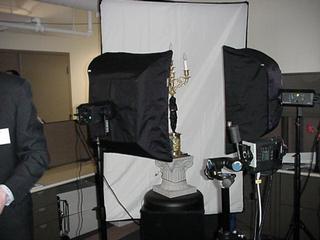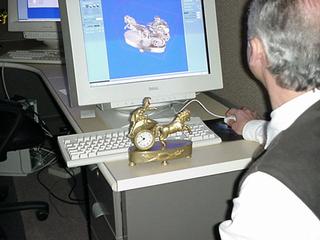
Candelabra being photographically captured.
"METASTREAM3 -
Technology"
>Page 1, 2,3
The main thing MTS3 has going for it is a great technology foundation. The quality of the 3D models are simply the best available on the net for Web-interactive 3D on Web pages. The color, textures and download times are fabulous.
The big technological win is the geometry compression MTS3 uses. The geometry progressively downloads so the user sees something almost instantaneously and as more of the model is downloaded the quality is refined.
In addition to the display Metastream has formed partnerships with both Minolta and Kodak to attack the problems of object capture. If, for example you had some complicated (i.e. gaudy) candelabra that you were dying to sell.

Candelabra being photographically captured.
Modeling such a beast would be prohibitive. Instead you can model it in 3D via a photographic method. The Metastream software captures 60 images as the object is rotated on a computer controlled turntable. This is nothing new and has been done for over five years using similar technology via Apple's QTVR. However in this case the process has been to a great extent automated and the objects are turned into a true 3D geometric mesh. The mesh can be tweaked by hand using Metastream's capture software.

Clock being edited by capture software.
According to the Metastream staff it would typically take an hour from start to finish to capture an object and have it ready for the Web. It's not quite 100% automatic, but darned close. In addition the quality of this type of photographically captured object is the best commercially available.
In addition to the 3D models Metastream has done a terrific job creating mechanism to create interactivity and to integrate the models within the web page. You can easily add interactivity via some simple JavaScript functions and/or via XML. You can even generate some geometry procedurally as describe on the Metastream Web site:
The shape of a MTS3 primitive object (i.e. cube, sphere, cone, cylinder, pyramid, plane) is generated procedurally rather than with a series of polygons. These simple primitive objects are generated on the fly by the MTS3 plug-in by loading the MTS3 XML properties that determine the attributes of these objects. The Cube Demo is an example of a primitive generated by the MTS3 plug-in. In this section of the demo we will generate a MTS3 primitive (cube) procedurally via XML and then assign textures that were created previously to sides 0-5 of the cube.
Metastream is taking the approach of giving away most of their development tools to encourage rapid dissemination and use of their technology. The next question is, of course, how are these folks going to make money?
Next page Business Model >Page 1, 2,3